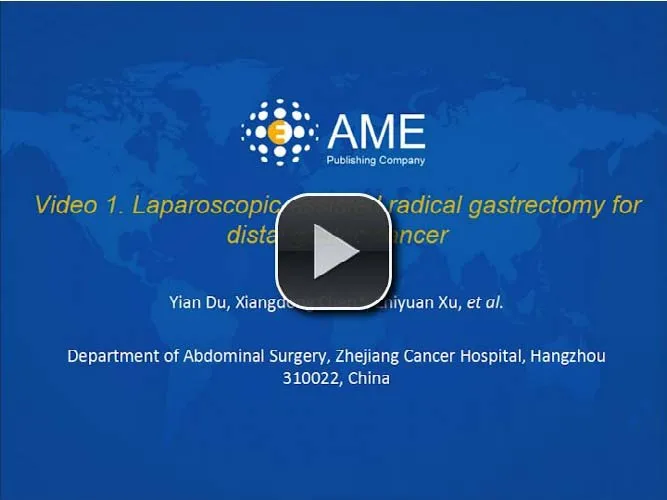Laparoscopic-assisted radical gastrectomy for distal gastric cancer
2013-06-12
Department of Abdominal Surgery, Zhejiang Cancer Hospital, Hangzhou 310022, China
Laparoscopic-assisted radical gastrectomy for distal gastric cancer
Yian Du, Xiangdong Cheng, Zhiyuan Xu, Litao Yang, Ling Huang, Bing Wang, Pengfei Yu, Ruizeng Dong
Department of Abdominal Surgery, Zhejiang Cancer Hospital, Hangzhou 310022, China
Corresponding to:Xiangdong Cheng. Department of Abdominal Surgery, Zhejiang Cancer Hospital, No. 38 Guang Ji Road, Hangzhou 310022, China. Email: chengxd516@126.com.
A 48-year-old female patient was diagnosed with a superficial depressed type early gastric cancer (type IIc) of 1.0 cm at the gastric angle as indicated by gastroscopy. Laparoscopic-assisted greater omentumpreserving D2 radical gastrectomy was performed in combination with Billroth I reconstruction under general anesthesia for the distal gastric cancer on April 5, 2013. The postoperative recovery was satisfying without complications. The patient was discharged seven days after surgery.
Early gastric cancer; gastrectomy; laparoscopic-assisted; D2 lymph node dissection
Scan to your mobile device or view this article at:http://www.thecjcr.org/article/view/2540/3413
As a novel minimally invasive surgical technique, laparoscopic radical gastrectomy is associated with such advantages as less injury, reduced postoperative pain, lower impact on immune function, rapid recovery of gastrointestinal function, and short hospital stay. In 1997, Goh and coworkers conducted D2 radical gastrectomy for advanced gastric cancer under laparoscope, which demonstrated the safety and feasibility in terms of the technique. In their reviews, Topal (1) and Huscher (2) also confirmed the above conclusion, and they suggested that the long-term survival outcomes of laparoscopic-assisted radical gastrectomy were similar to those of open surgery. Laparoscopic-assisted radical gastrectomy has now been recognized for treating gastric cancer with an invasion depth of T2 or less, without evidence of lymph node metastases in preoperative examination (3). On April 5, 2013, we conducted laparoscopic-assisted gastrectomy for a patient with early gastric cancer (type IIc). The postoperative recovery was satisfying. The details are as follows:
A 48-year-old woman was admitted to our hospital due to“upper abdominal dull pain with acid reflux for more than a month”. Gastroscopy suggested a superficial depressed type early gastric cancer of 1.0 cm at the gastric angle. Biopsies indicated adenocarcinoma at the gastric angle. Endoscopic ultrasound indicated disordered structure of the submucosal layer of the gastric lesion at the gastric angle. CT scan suggested slightly thickened gastric wall at the gastric angle, without enlargement of lymph nodes around the stomach or liver metastasis. Preoperative staging: T1bN0M0. On April 5, 2013, laparoscopic-assisted D2 radical gastrectomy was conducted under general anesthesia for the distal gastric cancer.
During the surgery (Video 1), the patient was placed in a supine position with legs apart. Following general anesthesia, CO2pneumoperitoneum was established at 12 cm water column. Laparoscopic exploration showed no peritoneal dissemination or liver metastasis nodules, so the surgeons decided to perform D2 radical resection while preserving the greater omentum. The gastrocolic ligament was cut open 2-3 cm away from the greater curvature through to the lower pole of the spleen. The left gastroepiploic vessels were denuded, and the left gastroepiploic artery was ligated and cut at the root. The station number 4sb lymph nodes were dissected. The greater curvature was denuded, and station number 4d lymph nodes were dissected.

Video 1 Laparoscopic-assisted radical gastrectomy for distal gastric cancer
The lymph nodes in the inferior area of the pylorus were then dissected. The station number 14v lymph nodes were typically not dissected in the standard D2 radical surgery. The anterior pancreaticoduodenal fascia was stripped close to the head of the pancreas to reveal the right gastroepiploic vein. During the separation, the non-working face of the ultrasonic scalpel was pointed towards the pancreas. Caution was made to avoid injury to the small vessels on the surface of the pancreas, particularly to the anterior superior pancreaticoduodenal vein. The right gastroepiploic vein was denuded, and transected before its junction with the pancreaticoduodenal vein. The right gastroepiploic artery was then denuded. The small vessels and subpyloric vessels emerging from the gastroduodenal artery and entering the posterior wall of the duodenum were treated first. This could reduce bleeding when separating the right gastroepiploic artery. After the right gastroepiploic artery was denuded, ligated and cut, the lower edge of the duodenum was denuded, and the station number 6 lymph nodes were dissected. The gastroduodenal artery was stripped to its root in an inverse direction. The common hepatic artery was dissected, and the right gastric artery was separated near the bifurcation, but was not transected for the moment.
A piece of sterile gauze was placed on the lesser sac to flip the stomach downward. The pylorus and the superior region of the duodenum were denuded, then the small omentum was opened, and the gauze was clearly visible. The duodenum was first transected, and the stomach was flipped to the left side to reveal the structure more clearly from the upper edge of the pancreas to the posterior wall of the lesser sac.
The anterior hepatoduodenal capsule was opened and the proper hepatic artery was divided. The right gastric artery was further denuded, ligated and cut at the root. The station number 5 lymph nodes were dissected. With the assistant gently lifting the gastropancreatic fold, the surgeon began to separate the superficial fascia on the upper edge of the pancreas. The gastropancreatic fold was dissected, and the coronary vein and the left gastric artery were denuded. After the coronary vein was denuded, a clamp was applied to the root and the vessel was transected. The left gastric artery was denuded from the periphery. An absorbable clamp was applied to 0.5 cm above its root and the vessel was transected so that the clamp would not slip off. The station number 7 lymph nodes were dissected.
The lesser sac was opened until the right edge of the cardia. The peritoneal reflection was opened to the anterior part of the right crus of the diaphragm to provide an accurate anatomic plane for the subsequent dissection of the station number 9 lymph nodes. The station number 12a lymph nodes were then dissected. The proper hepatic artery was gently pulled to the right side, and the fascia to the left was separated to naturally reveal the left anterior wall of the portal vein. The separation was continued along the upper edge of the fascia from the left side of the portal vein to the celiac artery, during which the stations number 12a and 8a lymph nodes were dissected en bloc. After the dissection, the entrance of the portal vein, splenic vein and coronary vein was clearly visible. The two stations were gently retracted to the left side, and the lymph nodes to the right of the celiac artery were dissected along the plane established anterior to the crus in the above steps, and the anterior region of the celiac artery was then dissected.
Afterwards, the lymph nodes proximal to the splenic artery were then dissected (number 11p). The fascia at the upper edge of the pancreas was separated towards the pancreatic tail to expose the splenic artery. It should be noted that there were several curves along the splenic artery to the splenic hilum, especially the largest one of 3 to 4 cm to the root, which was hidden behind the pancreas with lymph nodes inside that should not be omitted. Hence, we dissected the lymph nodes surrounding the splenic artery from both the anterior and the posterior directions. The dissection from posterior to anterior areas beginning from the left crus of the diaphragm would help ensure that the lymph nodes at the curves were not omitted. The supplying vessels along the lymph nodes around the splenic artery could be directly transected with the ultrasonic scalpel. After dissection, the lymph nodes were lifted to the anterior right side. The separation was then continued towards the cardia so that lymph nodes to the posterior and right ofthe cardia could be dissected. The right side of the cardia and the lesser curvature of the stomach were denuded, and the stations number 1 and 3 were dissected. At this point, the laparoscopic operation was is complete. An auxiliary incision of about 5 cm was made inferior to the xiphoid for the removal of the entire specimen. A Tyco 25# circular gastrointestinal stapler was used to complete the Billroth I anastomosis.
The whole operation lasted 3 hours and 10 minutes, with intraoperative blood loss of 20 mL, and no blood transfusion was delivered. The patient was able to ambulate three days after surgery. Liquid diet was prescribed on the 5th day and semi-liquid diet on the 6th day. The patient was discharged seven days after surgery without postoperative complications. Postoperative pathology showed a superficial depressed type moderately to poorly differentiated adenocarcinoma with superficial ulceration at the junction of the antrum and the gastric body on the lesser curvature side (size 1 cm × 1 cm × 0.2 cm), invading the submucosa. Chronic inflammation was noted in 2 (suprapyloric), 1 (subpyloric), 5 (lesser curvature), 3 (greater curvature), 2 (close to the left gastric artery), 1 (close to the common hepatic artery), 2 (close to the splenic artery), 2 (close to the celiac artery), 1 (12a), 1 (4sb), and 2 (to the right of the cardia) lymph node. Both upper and lower margins were negative. Postoperative pathological staging was T1bN0M0.
Acknowledgements
Disclosure:The authors declare no conflict of interest.
1. Topal B, Leys E, Ectors N, et al. Determinants of complications and adequacy of surgical resection in laparoscopic versus open total gastrectomy for adenocarcinoma. Surg Endosc 2008;22:980-4.
2. Huscher CG, Mingoli A, Sgarzini G, et al. Totally laparoscopic total and subtotal gastrectomy with extended lymph node dissection for early and advanced gastric cancer: early and long-term results of a 100-patient series. Am J Surg 2007;194:839-44; discussion 844.
3. Nakajima T. Gastric cancer treatment guidelines in Japan. Gastric Cancer 2002;5:1-5.
Cite this article as:Du Y, Cheng X, Xu Z, Yang L, Huang L, Wang B, Yu P, Dong R. Laparoscopic-assisted radical gastrectomy for distal gastric cancer. Chin J Cancer Res 2013;25(4):460-462. doi: 10.3978/j.issn.1000-9604.2013.08.15

10.3978/j.issn.1000-9604.2013.08.15
Submitted Jul 25, 2013. Accepted for publication Aug 14, 2013.
杂志排行
Chinese Journal of Cancer Research的其它文章
- Retreatment of a patient who presented with synchronous multiple primary colorectal carcinoma: report of a case
- Laparoscopy-assisted D2 radical distal gastrectomy for gastric cancer (Billroth II anastomosis)
- The role of circadian rhythm in breast cancer
- Laparoscopic gastrectomy for distal gastric cancer
- Total laparoscopic-assisted radical gastrectomy (D2+) with jejunal Roux-en-Y reconstruction
- D2 plus radical resection combined with perioperative chemotherapy for advanced gastric cancer with pyloric obstruction
